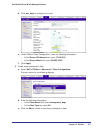
Chapter 12. DiffServ | 201
ProSafe M4100 and M7100 Managed Switches
• Class. A class consists of a set of rules that identify which packets belong to the class.
Inbound traffic is separated into traffic classes based on Layer 3 and Layer 4 header data
and the VLAN ID, and marked with a corresponding DSCP value. One type of class is
supported: All, which specifies that every match criterion defined for the class must be
true for a match to occur.
• Policy. Defines the QoS attributes for one or more traf
fic classes. An example of an
attribute is the ability to mark a packet at ingress. The 7000 Series Managed Switch
supports a traffic conditions policy. This type of policy is associated with an inbound traffic
class and specifies the actions to be performed on packets meeting the class rules:
- Marking the packet with a given DSCP code point, IP precedence, or CoS
- Policing packets by dropping or re-marking those that exceed the class’
s assigned
data rate
- Counting the traf
fic within the class
• Service.
Assigns a policy to an interface for inbound traffic.
DiffServ
This example shows how a network administrator can provide equal access to the Internet
(or other external network) to different departments within a company. Each of four
departments has its own Class B subnet that is allocated 25 percent of the available
bandwidth on the port accessing the Internet.
Internet
Port 1/0/5
Outbound
Layer 3 Switch
Port 1/0/1
Port 1/0/4
Port 1/0/2
Port 1/0/3
VLAN 10:
Finance
VLAN 20:
Marketing
VLAN 30:
Test
VLAN 40:
Development
Figure 22. Class B subnet with differentiated services
The example is shown as CLI commands and as a Web interface procedure.


















